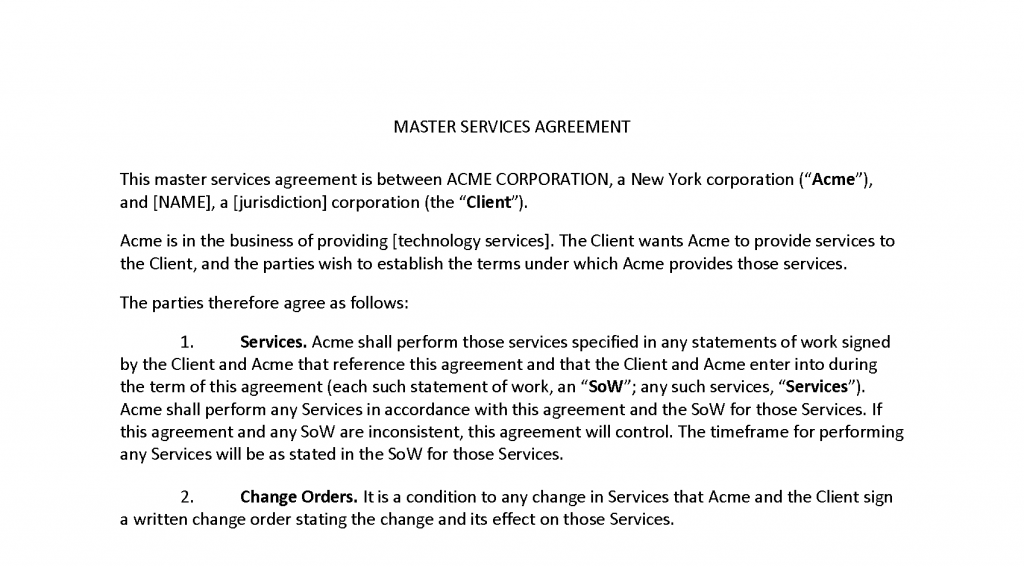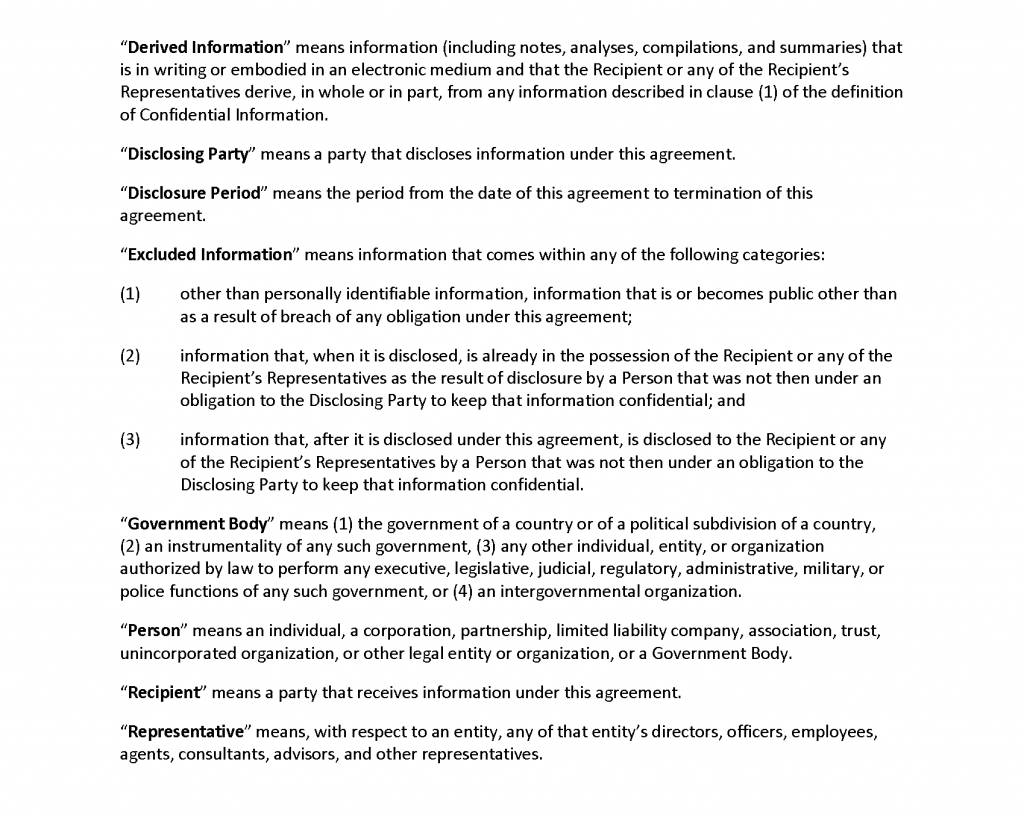Here’s what I say in MSCD 16.58–60:
One way to signal the start of a new paragraph is to indent the first line. Another way is to put space between paragraphs. Typography professionals recommend that you not use both techniques. For example, Typography for Lawyers, at 136–37, says, “First-line indents and space between paragraphs have the same relationship as belts and suspenders. You only need one to get the job done. Using both is a mistake. If you use a first-line indent on a paragraph don’t use space between. And vice versa.”
Contracts invariably use space between paragraphs. Given that reading contracts often involves flipping from provision to provision, that space seems indispensable. Furthermore, the logic behind the MSCD enumeration scheme (see 4.53) requires first-line indents for sections (see 4.13) and subsections (see 4.26). The result is that the MSCD enumeration scheme uses both space between paragraphs and first-line indents. In this case, the need for a logical layout trumps typography considerations.
In the samples in this manual and in the redrafted version of the appendix 1 contract, paragraphs without enumeration—the introductory clause, the recitals, the lead-in, the concluding clause, and autonomous definitions—all use first-line indents. Given the lack of enumeration, one could dispense with the first-line indents, but they’ve been retained for reasons of consistency between enumerated paragraphs and paragraphs without enumeration. Given that for contract drafters document design is generally a low priority, the notion of switching from first-line indenting for enumerated paragraphs to doing without for paragraphs without enumeration seems too fussy.
Well, I’m now inclined to say, the heck with that! I’ve decided that using first-line indents with spaced paragraphs just looks too silly. I was mildly annoyed that my article on represents and warrants (here) uses first-line indents with spaced paragraphs.
So here’s what the front of the contract would look like without first-line indenting:
This approach would apply to all unenumerated paragraphs. So here’s what a set of autonomous definitions would look like:
This approach would apply equally to the hanging-indent scheme I propose in this post. Obviously so: if none of the the enumerated paragraphs uses first-line indenting, it would be odd to use first-line indents for the unenumerated paragraphs.
Sorry for pulling this switcheroo on you.



Ken:
You are slowly progressing towards the right-thinking part of the universe!
Now, just put your section number and title on one line, with text immediately beneath it, both unindented, thus:
1 I’m a Section Title
I’m a bunch of text that goes on and on.
Among other things, this approach conforms with standards like HTML and makes it easier to use built-in features of MS Word, such as paragraph-based styles and auto-generated tables of contents from styles.
Chris
I know it doesn’t show on the blog, but are you bolding the section title or not?
AWB:
I do in most contexts. I didn’t bother trying to make it appear in the blog.
Chris
Ken,
1/ You have pointed out that single-spacing is MORE readable than double-spacing.
2/ You have pointed out that GENERAL ALLCAPPING (AKA SHOUTING) MAKES TEXT LESS RATHER THAN MORE READABLE.
3/ You have pointed out that deal points should come early in the contract body, and defininitions and other boring stuff farther along. Others have expressed this principle as ‘upfront the bottom line’ and ‘tell the reader without delay what the reader wants to know’.
4/ You have championed efficiency in contract drafting. Efficiency means good use use of limited resources to achieve desired results. I think the French call it ‘getting the biggest bang for the Euro’. In contracts, space, including white space, is a resource to be husbanded, if one is still allowed to use that word.
5/ You have said that tradition can be trashed if it’s dysfunctional.
6/ You have now said that it makes sense for unenumerated paragraphs not to be indented.
7/ You have given me so much ‘concision religion’ that I make bold to propose for consideration the following format rules (visually exemplified in a contract fragment at this URL: http://bit.ly/1Lc5Up8):
(a) Start a section at the left margin with its bolded caption, not preceded by a section number or the number’s preceding and following tab spaces. If the section has no subsections, put the section number, bolded and in square brackets, at the right end of the last line of the section text. If the section text ends exactly at the end of the line, put the section number at the end of the next (blank) line.
(b) If the section has subsections, treat the first subsection as above, but the number at the end of the subsection will be, eg, [7.a]. Start the second subsection at the left margin, bolding the first three words (which are not a caption, because subsections don’t have captions), and put the subsection number, bolded and square-bracketed, at the end as in 7 (a) above, eg, [7.b].
(c) If a section or subsection has what MSCD calls ‘tabulated enumerated lists,’ either treat them as at present, or make them all flush left with introductory numbers in round brackets. The justification for the latter, no-hanging-indent approach is that the left-side numbers in round brackets, being unique, will set the list items off enough without fancy indentation. In addition, such list will be uniquely without initial bolding.
8/ My extrasensory perception tells me you’ll shoot this proposal down faster than a turpentined cat, but I maintain it makes the contract more readable, with no loss of reader’s ease in following the enumeration — the learning curve will be close to zero.
9/ Chris Lemens, whose liking of left justification I share, will doubtless point out that, among other things, this approach neither conforms to standards like HTML nor makes it easy to use built-in features of MS Word, such as paragraph-based styles and auto-generated tables of contents from styles. To these objections I have no answer. If those considerations are paramount, the proposal fails.
10/ In any event, you have pointed to studies that show that the most readable font is the one to which the person being asked is most used. In that spirit, I suggest that readers will quickly become used to looking for bolded enumeration data on the right side of the page.
11/ Right-side, in-the-text-column enumeration avoids wasting prime page acreage (hectarage?) on information that is of only limited and occasional interest to the reader, and readily and visibly available when wanted. The result is shorter, easier to read contracts with no loss of navigability. The proponent rests his case.
–Wright
Forgive me if I park this comment until next spring, when I turn to MSCD4 in earnest.
Your first example is exactly the kind of contract I was editing when I read this post, an MSA governing SOWs. Thanks for the timely assist.
Gee, that was serendipitous!